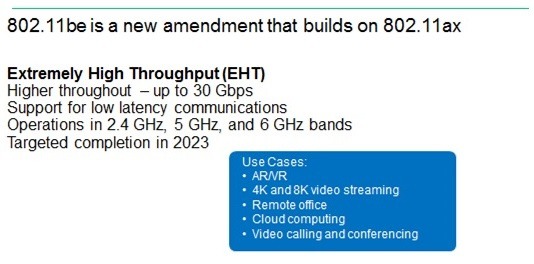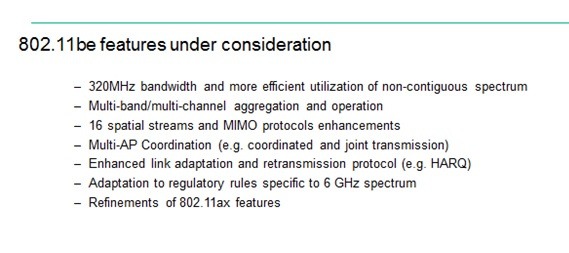WiFi 7: the next generation of WiFi technology
When developing an industry standard, a mutually agreed solution is crucial. Often this is a slow, inefficient and frustrating process. It is therefore surprising that, recently and in rapid succession, a number of advances have been made by the WiFi Alliance and the IEEE Standards Association regarding the 802-standard for Wireless Local Area Networks, better known as WiFi.
First of all, there is a new approach to naming by the WiFi Alliance. This gives users easier-to-understand terms for device-supported WiFi technology and connecting the device to a WiFi network. For nearly two decades, WiFi users have had to cope with cumbersome technical naming conventions to determine if their devices support the latest WiFi versions. Now, the naming system has been simplified in that WiFi generations are numbered at the most important levels of improvement. This means that 802.11n is now referred to as WiFi 4, 802.11ac is now called WiFi 5, and 802.11ax is WiFi 6.
However, from a technological point of view, perhaps even more important is the fact that the IEEE has already begun to develop the WiFi 7 technology, although WiFi 6 endpoints are only just beginning to be marketed by manufacturers.
WiFi 7 will take into account the fact that video will be the dominant type of traffic in the coming years. According to Cisco's most recent Visual Networking Index, by 2022, IP video traffic will account for 82% of total IP traffic worldwide (both enterprise and consumer). That's more than the 75% share in 2017. Specifically, by 2022, live web video will account for 17% of Internet video traffic
In addition, indoor WiFi traffic is expected to increase even faster as 5G mobile phones mature, as it is difficult for a 5G millimetre radio wave (mmWave) to penetrate a wall. The term mmWave refers to the part of the radio frequency spectrum between 24GHz and 100GHz with very short wavelengths.
As most of the world's mobile data is transmitted by WiFi devices connected to access networks, new usage models are driving the development of a new change to the WiFi standard known as 802.11be Extremely High Throughput (EHT) or in the new wording called WiFi 7.
Put simply, WiFi 7 can be considered as what you would get if you applied the requirements of 5G technology to a WLAN. This is appropriate, as WiFi 7 is expected to become an indispensable technology for 5G content and redirect 5G traffic to the WiFi system. Mobile, fixed and cable providers are already using WiFi as an extension or alternative to mobile because of their relatively low connection costs.
With the development of sophisticated technologies such as 8K Ultra High Quality Videos (with 7680x4320 pixels or four times as many pixels as a 4K TV and 16 times as many as a 1080p TV) and high resolution VR (Virtual Reality) or AR (Augmented Reality), the throughput of traffic per person will increase to hundreds of gigabytes.

The name WiFi Extremely High Throughput already says it all. Compared to the previous generation (WiFi 6, 802.11ax), WiFi 7 is expected to support up to 30Gbps of throughput, which is about three times faster than WiFi 6, and can exceed twice the number of frequencies use.

In addition, the IEEE standards development group recognises the need to improve WiFi transmission delay and jitter for real-time applications, including games, VR, external office apps, cloud computing, and medical use cases, with delays should be lowered to less than 5ms.
In the course of the work of the IEEE group, further details will certainly arise. In the course of this development, technological decisions are required. Here is just one example:
Simultaneous transmission and reception in the same or different bands
Simultaneous transmit and receive in the same band is referred to as in-band full-duplex (IBFD) operation. With IBFD, a wireless terminal can transmit and receive at the same time in the same frequency band. It is expected that this can be realised with minor changes to the 802.11 standard. Among its advantages are: higher throughput, lower latency and collision detection. A practical limitation of IBFD operation is the presence of intrinsic noise, i.e. the interference caused by the transmitter to its own receiver.
The use of different bands is commonly referred to as multi-band full-duplex. It also has the potential to reduce communications latency and increase throughput by allowing asynchronous and concurrent uplink / downlink operation in separate bands. If this feature is integrated with EHT, there will likely be minimal separation between the downlink and uplink channels to avoid interference.
Another more fundamental decision is how quickly the WiFi 7 standards can be passed. As mentioned earlier, major changes to IEEE 802.11, such as: IEEE 802.11n or IEEE 802.11ax, six years or more, with the development process consisting of forming a working group, defining functionalities, drafting and describing a certification process.
However, given the rapid pace of development of new and co-existing technologies, speeding up the process would help meet market demands more quickly. However, traditionalists argue that the development group could achieve major technical improvements on many fronts if a longer maturation period could be used.
Which way is ultimately committed, will show.
Guest article written by Murray Slovick, Editorial Director and Principal of Intelligent TechContent.
Courtesy of u-blox.



